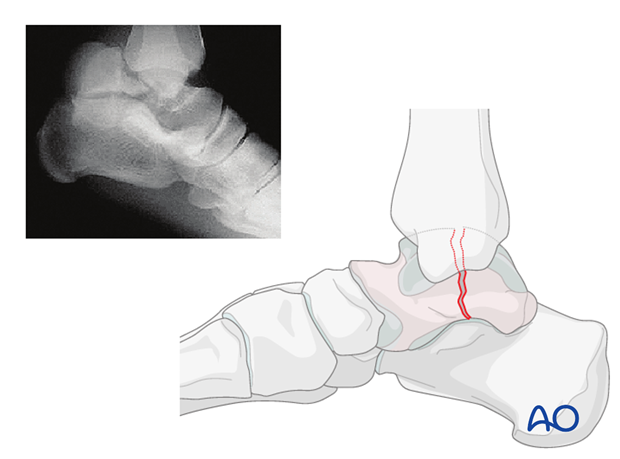Body
Fracture occurrence
Talar body fractures occur with axial load and a foot with muscles in tension holding the foot in a rigid position. Commonly, motor vehicle crashes cause the foot to be axially loaded with the foot plate of the car impacting a dorsiflexed foot on the brake pedal. Associated soft-tissue injury can occur, especially with increasing severity. Open talar body injuries or other foot and ankle pathology often are part of a spectrum of injury.

Radiology
X-ray diagnosis is necessary using standard AP and lateral x-rays of the ankle and foot, with supplementary Canale views.
These x-rays are often difficult to interpret as there is more displacement or associated subluxation, or dislocation, of the ankle or hindfoot.
CT scans are necessary to determine accurately the hindfoot pathology. One should not miss minor things such as osteochondral fratures, or subtle subluxations, as these details are important for correct preoperative planning and approaches.

Anatomy
The blood supply to the body of the talus is complex. Most of the blood supply to the body is through the deltoid branches of the posterior tibial artery. The dorsalis pedis and peroneal artery supply the neck and the lateral third. Fracture dislocations can easily compromise the blood supply to the body of the talus and lead to avascular necrosis.

Note the deltoid branches of the posterior tibial artery and the artery of the tarsal canal. A posteromedial approach to the body of the talus would destroy its blood supply. Therefore, if the body has to be exposed, one utilizes an osteotomy of the medial malleolus.

The deltoid branches are important to supply blood to the medial talar neck and talar body. Branches from the dorsalis pedis supply the talar head and most of the dorsal talar neck. The artery of the tarsal canal coming from branches off of the posterior tibial artery supply most of the talar body.
The peroneal artery has the least contribution laterally.

Classification
Müller AO/OTA Classification
A classification of fractures is only useful if it indicates the severity of injury, the difficulties to be encountered in treatment and its outcome. In the Müller/AO classification fractures of the talar body are denoted as C-type. The members of the group C1, C2 and C3 are organized in an ascending order of severity. This means that they are not only more difficult to treat, but that the prognosis is progressively worse. A multifragmentary fracture with many fragments bearing articular cartilage becomes exceedingly difficult to reduce, and residual articular deformities lead to devastating complications. One must also keep in mind that with increasing energy, forces are also dissipated to the soft tissues, and the soft-tissue component of the injury may compromise the outcome as much as, if not more than, the injury to the bone.
Avascular necrosis is increasingly common with increasing severity.

Ankle joint involvement (C1)
The images demonstrate osteochondral injury to the superior dome of the body of the talus.

Subtalar joint involvement (C2)
The images demonstrate a coronal split through the body of the talus. The posteriorly displaced half of the body has lost all its blood supply. Avascular necrosis is unavoidable and prognosis is poor.

Ankle and subtalar joint involvement (C3)
Comminution with the body of the talus is the most devastating injury as congruency after reconstruction is often impossible, or at least compromised with poor longterm outcome forecasted.














